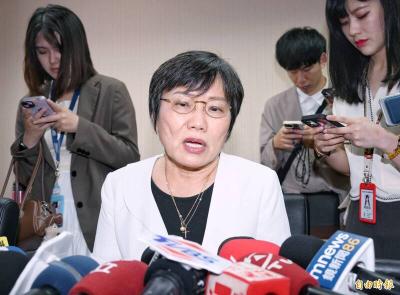A clinical trial developed by a Taiwanese research team has offered a glimmer of hope for patients of neuroblastoma, a malignant cancer that appears in early childhood, a press statement released by the Academia Sinica said.
The research team at the research institute has proven that a combination of anti-cancer monoclonal antibodies (mAbs) with cytokines (natural hormones that help the immune system) is an effective anti-cancer therapy.
The new immunotherapy treatment pioneered by the research team, headed by Alice Yu (陳鈴津), deputy director of Academia Sinica’s Genomics Research Center, is the first study that confirms that immunotherapy is effective in improving cure rates for this childhood cancer, the statement said.
Yu, a pediatrician, has been working on the therapy for more than 20 years. She completed the Phase I and Phase II trials of this antibody at the University of California in San Diego.
The latest Phase III trial was sponsored by the US-based Children’s Oncology Group (COG), a cancer research organization, and the National Cancer Institute of the National Institutes of Health in the US. The latest results included children with neuroblastoma from many parts of the world.
Neuroblastoma is a malignant cancer occurring in early childhood in which the cancer cells arise from the nerve cells in the neck, chest or abdomen.
It is the most common cancer diagnosed in the first year of life and is responsible for 15 percent of cancer-related deaths in children.
The Phase III study showed that children with high risk neuroblastoma who received the new antibody-based immunotherapy (chimeric anti-GD2 antibody ch14.18) have a 20 percent better chance of living free of cancer, a significantly improved cure rate.
So far, Yu said, all US Federal Drug Administration (FDA) approved therapeutic anti-cancer mAbs or vaccines are directed against protein or glycoprotein antigens.
“The Phase III clinical trial is the first mAb targeting a glycolipid that has been shown to be effective,” Yu said.
More importantly, she added, this is the first study that proves that immunotherapy is effective in improving cure rates for this childhood cancer and her team is now focusing on making sure immunotherapy can be available to all children with this disease and on improving results.
COG Chairman Gregory Reaman stated in a press release that the clinical benefit of this approach against the notoriously stubborn child cancer is extraordinary and that the COG is anxious to continue its investigation to better define the toxicities and confirm its satisfactory risk-benefit ratio.
“We are hopeful that that this further study will result in commercialization and FDA approval and licensing of this experimental immunotherapeutic agent so that it can be made readily available as standard therapy to all children with this dreaded disease,” Reaman said in the statement.
Conventional treatment for the disease includes surgery, intensive chemotherapy with stem cell rescue (in which patients’ stem cells removed before treatment are returned after chemotherapy to repopulate the blood and immune system) and radiation therapy.
Despite these aggressive measures, only 30 percent of patients survive.
The immunotherapy evaluated in this study targets a specific glycolipid (sugar and fat) molecule on neuroblastoma cells called GD2 — which inhibits the immune system from attacking cancer cells — with an antibody called ch14.18.
This antibody binds to GD2 and provokes an attack by different types of immune cells against the cancer.
In her study, Yu and her colleagues compared the two-year event-free survival rate (the ratio of patients who were still alive and did not experience a recurrence) of 113 neuroblastoma patients who received the standard treatment (retinoic acid) plus the newly developed immunotherapy with 113 similar patients who only received the standard treatment.
The event-free survival rate for the immunotherapy group was 66 percent, compared to 46 percent for the standard treatment group. The most common side effects in the immunotherapy group were pain, vascular leak syndrome and allergic reactions.
As the study is the first effective immunotherapy reported for the disease and the first improvement on neuroblastoma cure rates of the last 10 years, it has drawn worldwide attention and was reported in USA Today and by US television network CBS.
It is estimated that it will take at least another two years to get FDA approval for the therapy.

Chinese Nationalist Party (KMT) Chairman Eric Chu (朱立倫), spokeswoman Yang Chih-yu (楊智伃) and Legislator Hsieh Lung-chieh (謝龍介) would be summoned by police for questioning for leading an illegal assembly on Thursday evening last week, Minister of the Interior Liu Shyh-fang (劉世芳) said today. The three KMT officials led an assembly outside the Taipei City Prosecutors’ Office, a restricted area where public assembly is not allowed, protesting the questioning of several KMT staff and searches of KMT headquarters and offices in a recall petition forgery case. Chu, Yang and Hsieh are all suspected of contravening the Assembly and Parade Act (集會遊行法) by holding

PRAISE: Japanese visitor Takashi Kubota said the Taiwanese temple architecture images showcased in the AI Art Gallery were the most impressive displays he saw Taiwan does not have an official pavilion at the World Expo in Osaka, Japan, because of its diplomatic predicament, but the government-backed Tech World pavilion is drawing interest with its unique recreations of works by Taiwanese artists. The pavilion features an artificial intelligence (AI)-based art gallery showcasing works of famous Taiwanese artists from the Japanese colonial period using innovative technologies. Among its main simulated displays are Eastern gouache paintings by Chen Chin (陳進), Lin Yu-shan (林玉山) and Kuo Hsueh-hu (郭雪湖), who were the three young Taiwanese painters selected for the East Asian Painting exhibition in 1927. Gouache is a water-based

Taiwan would welcome the return of Honduras as a diplomatic ally if its next president decides to make such a move, Minister of Foreign Affairs Lin Chia-lung (林佳龍) said yesterday. “Of course, we would welcome Honduras if they want to restore diplomatic ties with Taiwan after their elections,” Lin said at a meeting of the legislature’s Foreign Affairs and National Defense Committee, when asked to comment on statements made by two of the three Honduran presidential candidates during the presidential campaign in the Central American country. Taiwan is paying close attention to the region as a whole in the wake of a

OFF-TARGET: More than 30,000 participants were expected to take part in the Games next month, but only 6,550 foreign and 19,400 Taiwanese athletes have registered Taipei city councilors yesterday blasted the organizers of next month’s World Masters Games over sudden timetable and venue changes, which they said have caused thousands of participants to back out of the international sporting event, among other organizational issues. They also cited visa delays and political interference by China as reasons many foreign athletes are requesting refunds for the event, to be held from May 17 to 30. Jointly organized by the Taipei and New Taipei City governments, the games have been rocked by numerous controversies since preparations began in 2020. Taipei City Councilor Lin Yen-feng (林延鳳) said yesterday that new measures by